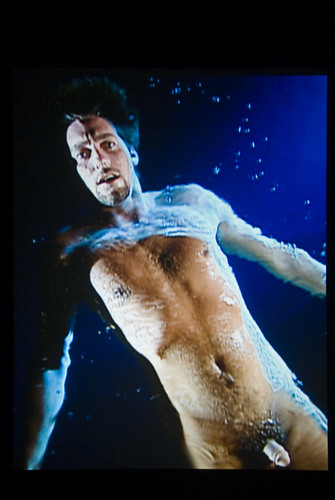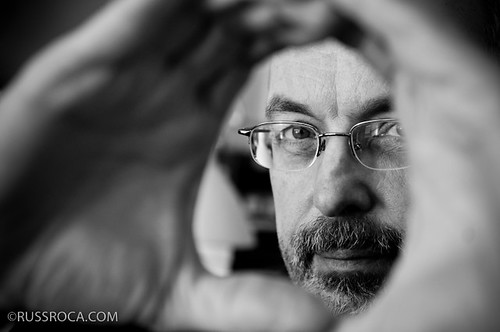The recurring water motif in Bill Viola’s video work is a glimpse of a hidden dimension – as is the digital world

Reeds. A fish. Light slanting and glinting through the water. The boy was entranced, mesmerised. When he felt his uncle’s large rescuing hands around his small body, he tried to squirm away, reluctant to leave the watery beauty.
Anyone who knows the 40-year career of the grandmaster of American video will know what water means in this artist’s work. Messiah-like figures are drenched in brilliant cascades, or sink through an apparently endless watery element in a shower of jewel-like bubbles, or walk through a redemptive wall of water to emerge into brilliant colour. Water is often magically beautiful; always powerful but seldom dangerous. Even in his “The Raft”, an intensely painterly piece of 2004 ripe with the Old Master allusions that are one of his specialities, the line of ordinary people blasted with a terrifying lateral tsunami that knocks them off their feet ends with an emotive resolution.
Again, in one of his new works, “The Dreamers”, just opened at London’s Blain Southern gallery, a gallery of life-sized, fully clothed people “sleep” underwater, the undulating ripples gently distorting their features like a funfair crazy mirror. But, submerged in such treacherous gentleness, are they dreaming – or drowning? And why do these vividly beautiful and peaceful images provoke such unease for the viewer?
Such layers of meaning and emotional response, evoked by mesmerising, often ritualistic imagery of almost painful clarity, are Viola’s hallmarks. Obviously, as so often with this artist, we are deep into the interior world in this work. The strong religious echoes and images in his art over many years have always been noticed, but he doesn’t profess any particular organised religion. Growing up in Flushing Queens, New York, his English mother took him and his sister and brother to church. The young Viola relished the rituals and the sense of the seasons changing – but “of course I grew away from that”. “But there is another dimension – you can feel that; everyone can feel that. We all have an enormous internal world – it’s without limits – and in that way it’s like the digital world. Inside your being is infinite ...”
This is something of a surprise. We’ve moved in a single step from the interior realm to digital technology. Even Kira Perov, Viola’s wife and working partner since 1977, looks a little startled. Perov is sitting beside Viola, as she sat with him during our earlier conversation in Venice – she is, he says, the person who makes his work possible. She takes care of the studio and the organisation of their lives, so that, he tells me, “I can be the dreamer.” They seem like two inseparable halves of one creative enterprise, mutually reliant and mutually supportive. Even their two sons – who often appear as actors in the videos – are part of the project.
Viola continues with his view of the digital/spiritual world: “Young people are in an interesting place right now. They use the word ‘spiritual’ in quite a different way. They’re talking about something inside themselves that they understand because of the digital age, because of their iPods and iPads and things. They know the virtual world and they accept that it’s intangible, it’s a different reality.”
Still struggling slightly with the notion that today’s digital technology has helped a young new generation to understand the spiritual aspects of themselves, I ask tentatively about the technical aspects of Viola’s work. Could there be a disconnect, I wonder, between the themes of timelessness and deep sense of cultural history in the work, and the ephemeral nature of technological art? A leading figure and something of a role model among artists whose expression depends on new media he may be, but his subject matter is the depth of human experience.

A couple rehearsing the same quarrel over and over again in Viola's new show ‘Frustrated Actions and Futile Gestures’
“Obviously, it’s a concern ... ” Viola begins – but technology is clearly Perov’s department. She and her team in the studio continually migrate the works to update them, a task that is getting more intense as the technological changes get faster and faster. “It’s expanding exponentially,” she says. Viola worked with analogue for almost 25 years, starting out lugging the 25lb Portapacs on his shoulder. Even after the advent of digital technology in the 1990s, Perov says, “we used to have quite a number of years with a certain medium, but now it’s shorter and shorter and shorter, sometimes only a matter of months.”
Viola is highly unusual as an artist: he was born (in 1951) at the same moment as his medium. “It was the luck of the draw,” he says. “Generally speaking there is a continuum, a continuum of all knowledge and all creative work, so we are always looking to the past whether we realise it or not.”
But when he went to art school at the end of the 1960s, he and his peers realised that this completely fresh medium was in their hands. “It was like the breaking of a dam,” he says, “like an empty pasture just stretching our before us. We were just enamoured of the whole thing. We could do anything.”
And as Perov points out, “because the medium kept developing, so the palette kept growing. And it was the artists who pushed it forwards, who kept on exploring what it could do, who kept thinking of new uses of the technology.” She laughs as she remembers more conventional film-makers amazed at what they were doing with video techniques.
Back in the present, Viola’s new show, called Frustrated Actions and Futile Gestures, has a surprisingly bleak title for a man who seems so balanced and contented. In the multi-panelled title piece, a glass leaks water, a Sisyphus figure laboriously pulls a cart up a hill only to watch helplessly as it rolls all the way back down again, a couple rehearse the same quarrel over and over, and a pair of men in a boat bale water endlessly in and out of their vessel.
Water, again. And the mystery of water, again, as a pair walk through the Mojave desert in the Mirage series. In a stunning diptych piece, Man Searching for Immortality/Woman Searching for Eternity (2013), life-sized septuagenarians very slowly explore their own naked bodies with torches, posed against black granite slabs that seem to be their own tombstones. It’s an eloquent disquisition on ageing – but Viola, only 62 and at the height of his powers, is surely a very long way from fading into the blackness.
‘Frustrated Actions and Futile Gestures’, Blain Southern gallery, London, until July 27. www.blainsouthern.com
![Bill Viola Ocean Without a Shore [selections], 2007](http://farm8.staticflickr.com/7023/6543722087_5681539fd8.jpg)


Niciun comentariu:
Trimiteți un comentariu